In content marketing and SEO, topic clusters are pieces of content strategically organized around a certain topic, called “the pillar content,” to establish topical expertise on a specific subject. Each cluster includes,
- Pillar page content: An authoritative piece of content that summarizes a topic within your niche. It’s also referred to as a content hub, from which subtopics (like spokes) protrude.
- Several subtopics (spokes) generated from the pillar content to cover the subject in detail
- Hyperlinks that connect all the subtopics in the cluster, as well as the main pillar content
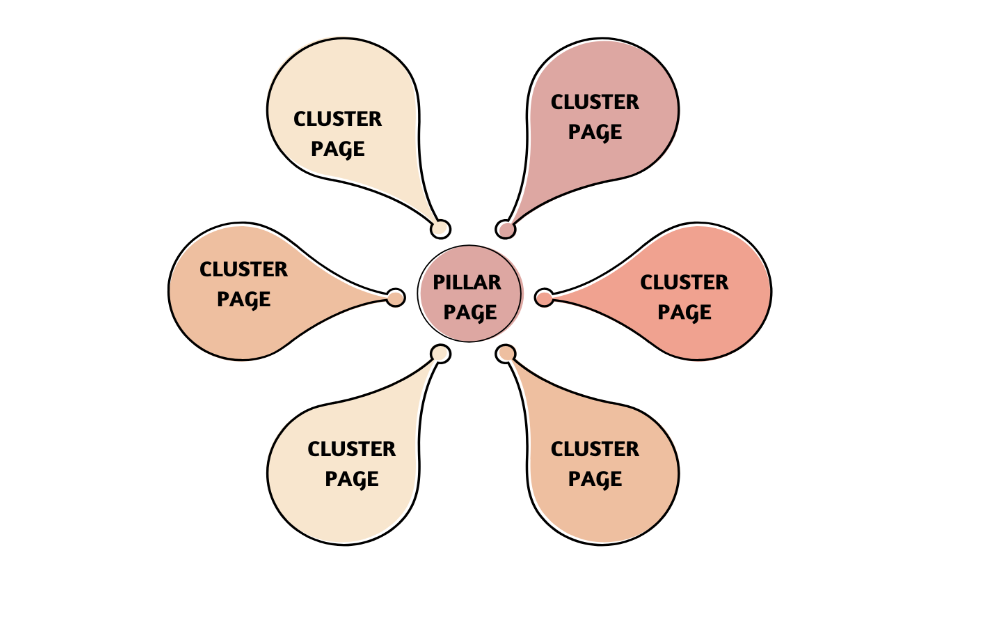
As the competition to rank on SERPs (Search Engine Results Pages) grows more intense with each passing day, the topic cluster model helps establish expertise on the topics you wish to develop your content marketing activities around.
Creating a topic cluster requires a strategic understanding of each topic and its significance for the audience. It should cover the user intent and provide readers with authentic information on the subject. The primary aim of each cluster should be to cover every relevant detail on the topic, explain it, and leave the users with no unanswered questions.
If all these conditions are met, your topic cluster will take your website to the top of SERPs without hassle.
How will topic clusters help transform SEO in 2025 and beyond?
For many years, search engines were focused primarily on keywords or search terms that people use to look for products/services/information on the internet. For the last few years, however, there has been a shift in this tendency. Search engines now seem more biased towards content creators, who cover user intent properly through in-depth, relevant, and interlinked information, i.e. topic clusters.
The keyword-to-topic priority shift has changed the entire model of search engine optimization. This trend will probably stay for some time before something new comes in the ever-evolving digital landscape.
So if you’re not yet aware of how creating content in the form of clusters can benefit your SEO endeavors, this is the best time to learn.
Optimized user experience
Search engines are favoring and prioritizing user experience above everything these days. It means that if the users are happy exploring your website, the search engines will be too.
Topic clusters in SEO define high-level user experience.
How? Well, they offer a structured form of content to the users to extract all the information they can regarding a certain topic. Clustering your content also helps achieve the E.E.A.T. ranking factor in SEO.
In each topic cluster, the pillar page constitutes the main source of comprehensive information on a certain topic, while the sub-pages act as additional information resources or references. Hence, the users don’t face much hassle looking for information on a website, as everything is well-organized and relevant to the main topic.
Websites that have their content scattered throughout the digital space make it difficult for users to navigate. Topic clusters, on the other hand, are user-centric and optimized for search engines as well. They can be compared to the particular sections of a library, where readers can fulfill their intent through authentic and in-depth information.
Easy implementation of primary search terms
Search engines favoring user intent not only means that it focuses on topical searches but also search terms. After all, it’s the keywords (search terms) that help connect the dots in Semantic SEO. While users may search for anything on the internet, it’s the job of the search engines to understand their intent and offer them relevant information accordingly.
In topic clusters, you can enhance keyword optimization like a pro. While the central topic can target primary keywords with high search volume, the consecutive sub-pages can target relevant keywords around the main topic.
Let’s say you have a fashion website that sells various kinds of bottom wear for women. Now, you want to create a topic cluster on – How to choose trendy bottomwear this holiday season. While the primary keyword can be trendy bottomwear for women, the subtopics can target other relevant search terms, like types of trousers, how to style cotton trousers, what to wear with bell-bottom jeans, etc.
This organized keyword optimization will not only please your audience, but also search engines. Your content will find its way to the top with information that helps people make the best shopping decision with a 90% chance of that happening on your website.
Hassle-free content management
Scattered pieces of unlinked content can confuse users, search engines, as well as content managers. With an organized topic cluster, you can update any content at any time without much hassle. As all the content in a cluster is interlinked, you can manage them seamlessly. If there’s any issue, like some information needs to be updated, or a keyword included, you can do so efficiently.
You can also add a personalized touch to each cluster through specific designs. That makes it visually appealing to the audience, thus boosting click-through rates (CTR). In other words, managing content in a cluster is way easier than optimizing scattered pieces.
Increased chances of search engine rankings and visibility
After all, every website craves for its message to be seen (and heard) by its target audience. Topic clusters can help achieve that goal.
The centralized piece of content (pillar page template) serves as the primary, authorized source of information linked to other relevant sources of additional information (subtopics). It fulfills the user intent and establishes topical authority on a particular subject. Linked to it are relevant subtopics, creating a network of valuable information resources that the user needs. The interlinking also serves as a guide map for search engines to find and index your content without a hitch.

With each subtopic targeting a set of key phrases relevant to the primary keyword of the core topic, keyword optimization is at its peak. Whatever search term the users put in the tab, the search engines will find your content fulfilling both user intent and visibility requirements. As a result, your content will be ranked at the top of SERPs.
How to build a topic cluster from scratch
Topic clusters help search engines better understand the content structure of your website. They also help users get all their information on a topic from a single, interlinked resource. But how to create a topic cluster that stands out? Scroll on!
Step 1: Pick a topic based on your market niche
While choosing a topic to build a cluster, you should have 5 things in mind:
- It should hold tremendous significance to your target audience (high search volume)
- It should be related to your website’s key purpose (the services/products you offer)
- It should be broad enough to create multiple subtopics but focused on a centralized theme
You can either create a content cluster manually, or you may take the help of tools, like Semrush, to do the job for you. Let’s take the example below.

As you can see in the image above, the content creator wishes to write on “AI in marketing”. The topic is broad enough to be classified into multiple subtopics, each with high informational intent. You can see that there are some primary keywords to be targeted in the core topic, as well as a cluster of relevant key phrases to optimize the subtopics.
The tool also gives you an idea about the global search volume for the primary keyword – AI in marketing. If you click on other relevant keywords, you’ll get an overview of their search volumes as well.
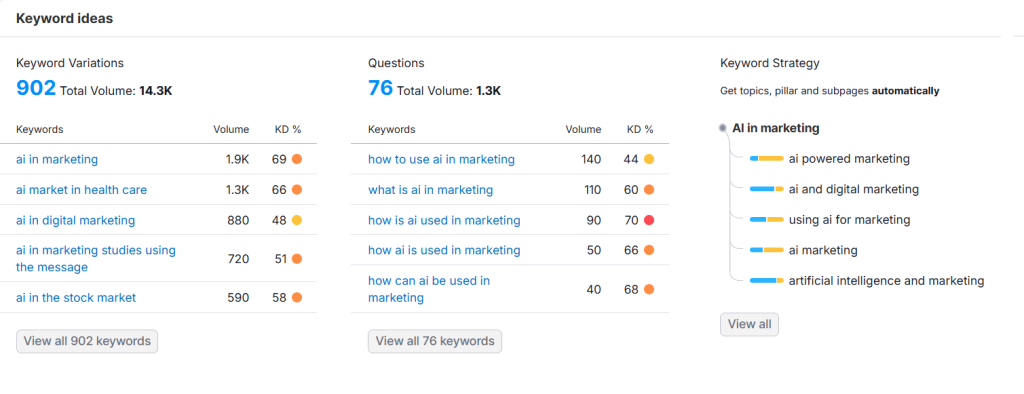
Semrush can also help create the cluster for you if you want.
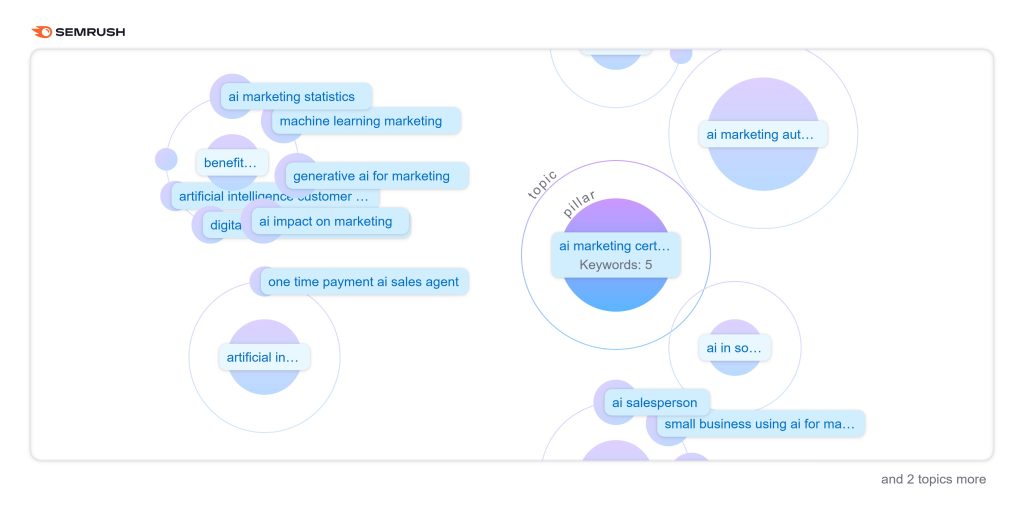
In simple words, you should go for a topic that is broad enough to create multiple subtopics but limited enough to prevent unnecessary clutter.
Step 2: Conduct topical research for each topic
You should research each topic individually along with their related search terms to understand the potential of the articles you’re going to write on them. For that, you need to first list down high-authority websites that cover similar topics. You can also use the search terms to check what information the users seek on the chosen topic.
Wikipedia is a good reference for creating in-depth topic clusters. You can also follow other authoritative websites on the particular niche. We suggest Wikipedia because of its linking pattern that can help you build the cluster with minimum effort. If you study a page on the website, you’ll notice that they have several internal links on the main page, taking you to the related subtopics filled with additional information.
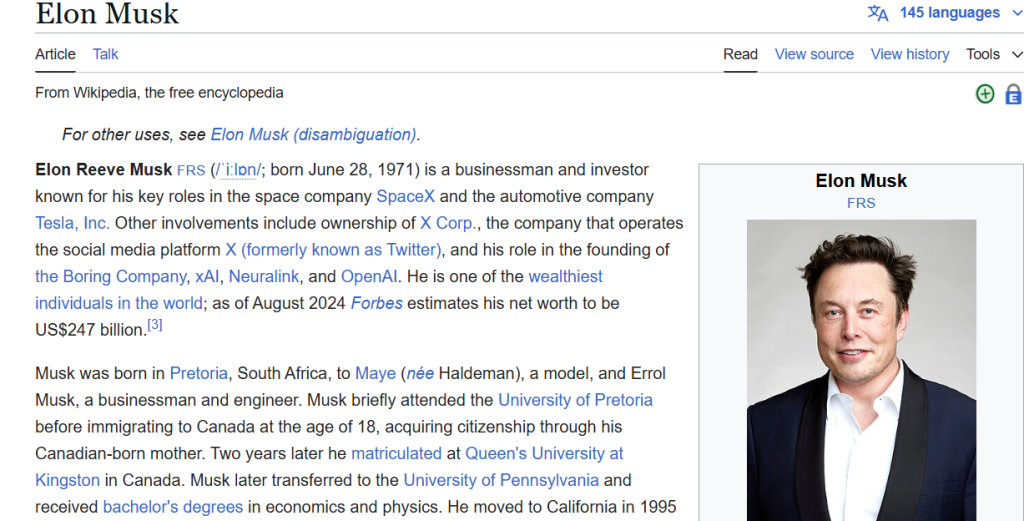
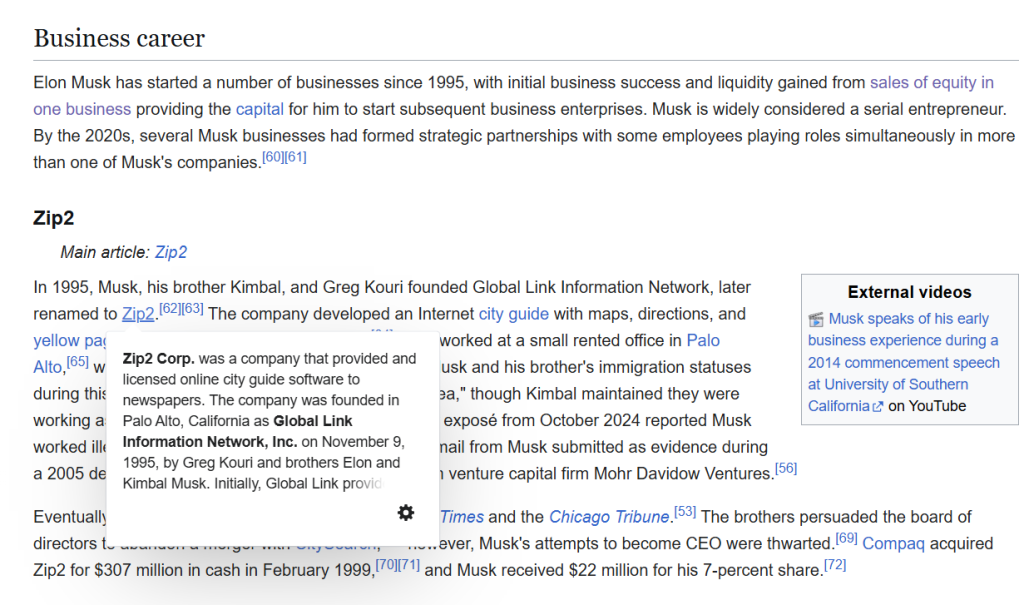
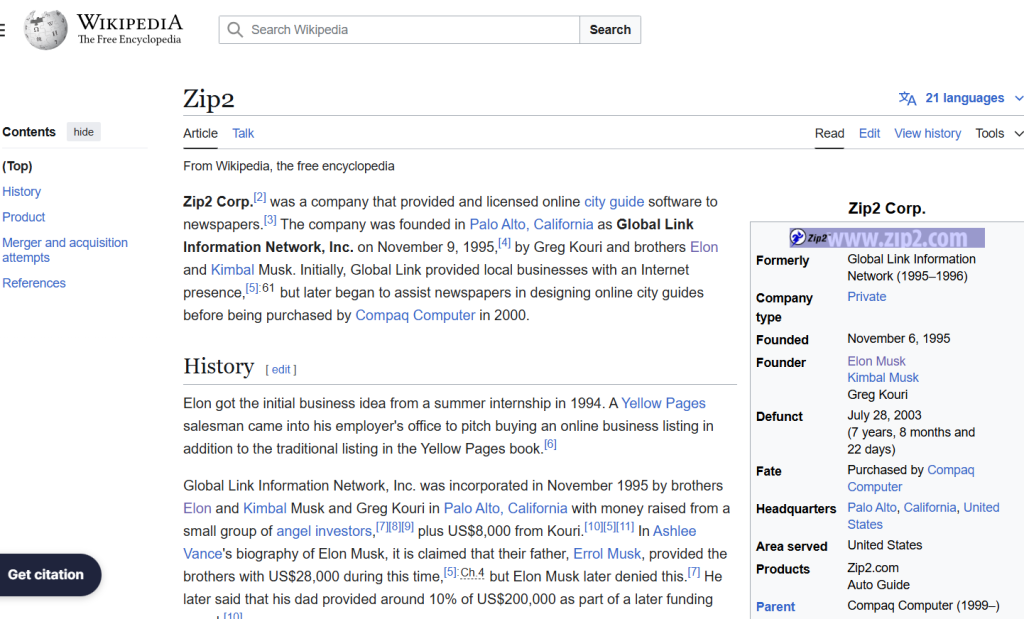
However, not all topics are covered by Wikipedia. No worries! You can use the targeted search terms to get an idea of what the users want.
Step 3: Create the pillar page content on the core topic
The pillar page content should be a comprehensive summary of the topic. It should introduce the topic first, fulfill user intent, enhance searchability, and then cover all the subtopics in brief. It should make the users understand the topic in-depth and look for additional information if needed.
- Firstly, decide the core topic of the cluster, something that will stand out and create an impact on the search engines.
- Secondly, create a list of search terms that you’re going to use in the core content. Go for high-competition keywords that will help increase your visibility on the search engines.
- Thirdly, cover all the subtopics in brief to make interlinking easier and hassle-free.
- Lastly, use authentic sources of information to create the content. It will help establish topical authority on the subject.
Step 4: Create the subtopics and link them all
For the subtopics, you should target relevant, long-tail keywords that users put in the search tab to seek information on the topic. For example, if the core topic is about types of musical instruments, the subtopics can be about how to play a certain instrument, maintenance tips for a musical instrument, etc. You should link all the subtopics to each other, as well as the core topic to complete the cluster.
In case you can’t think of multiple subtopics through manual research, you can take the help of effective tools. You can also use a keyword research tool to analyze each search term for all subtopics before you set down to create the content. Make sure that the subtopics are relevant to the core topic, including the keywords. Always keep in mind that the subtopics will function as additional information resources or references to the main topic for users.
Once you have linked all the pieces of content, a cluster is formed, improving the chances of high visibility, ranking, and of course, an enhanced user experience.
Strategic tips to build a high-performing topic cluster
Now that the basics have been covered, we would like to present you with some effective hacks to create a high-performing content cluster that both users and search engines will fall in love with.
- Before selecting a topic, underline some of the key issues that your buyer persona may be facing. You can run online surveys, create social media polls, or even interview the audience to understand the issues they face and what they expect from your brand.
- Create a core topic around each problem and do intensive keyword research to develop the subtopics. That way, each issue will be resolved strategically, thus fulfilling the user intent.
- You should include industry stats, real-time data, facts, and case studies wherever possible to validate the information you give. Check out the websites of your rivals and see how they are addressing the problem.
- After publishing the content, track, monitor, and measure every user metric, like CTR, bounce rates, conversion rate (calculated by the no. of subscriptions to your blog), etc.
- Keep updating the content according to the latest industry developments.
Once you have narrowed down to the core topic and the related subtopics, you’ll see that keyword research and content creation become a cakewalk. The organized structure of your content cluster will help users get all the information they want from you. The search engines will be happier to serve the users with relevant information, thus increasing your website’s chances of ranking high.
Over to you
When you understand the significance of topic clusters, you can take your SEO game to the next level. Search engines are more focused on users than websites these days. An organized, centralized information resource can help your website rank at the top by fulfilling user intent properly.
Creating a content cluster requires proper research and the right tools if necessary. You need to select a core topic that is broad enough to cover multiple subtopics, yet comprehensive and clutter-free. Research key search terms to select the subtopics that will act as additional information resources. Once the content is created, you need to link all the subtopics to each other, and the core topic to complete the cluster.
Structure and organization are the keys to achieving SEO success after all!